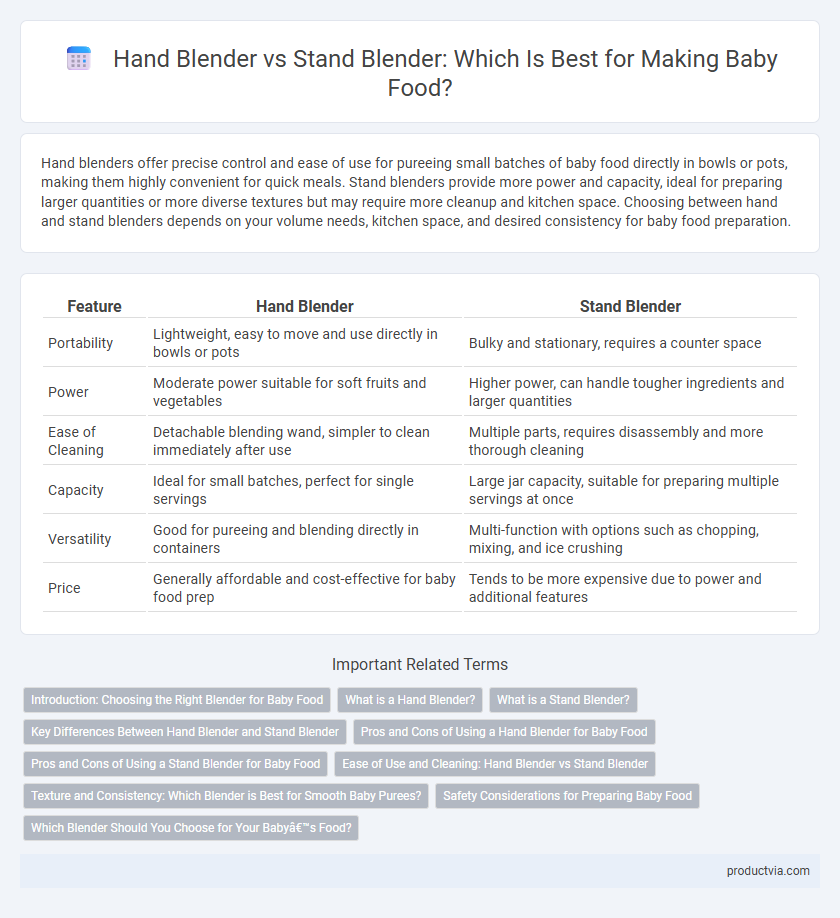Hand blenders offer precise control and ease of use for pureeing small batches of baby food directly in bowls or pots, making them highly convenient for quick meals. Stand blenders provide more power and capacity, ideal for preparing larger quantities or more diverse textures but may require more cleanup and kitchen space. Choosing between hand and stand blenders depends on your volume needs, kitchen space, and desired consistency for baby food preparation.
Table of Comparison
| Feature | Hand Blender | Stand Blender |
|---|---|---|
| Portability | Lightweight, easy to move and use directly in bowls or pots | Bulky and stationary, requires a counter space |
| Power | Moderate power suitable for soft fruits and vegetables | Higher power, can handle tougher ingredients and larger quantities |
| Ease of Cleaning | Detachable blending wand, simpler to clean immediately after use | Multiple parts, requires disassembly and more thorough cleaning |
| Capacity | Ideal for small batches, perfect for single servings | Large jar capacity, suitable for preparing multiple servings at once |
| Versatility | Good for pureeing and blending directly in containers | Multi-function with options such as chopping, mixing, and ice crushing |
| Price | Generally affordable and cost-effective for baby food prep | Tends to be more expensive due to power and additional features |
Introduction: Choosing the Right Blender for Baby Food
Hand blenders offer precise control and easy maneuverability, making them ideal for pureeing small batches of baby food directly in bowls or pots. Stand blenders provide powerful blending capabilities and larger capacity, suitable for preparing multiple servings or more complex recipes. Selecting between them depends on desired convenience, portion size, and storage space within the baby food preparation routine.
What is a Hand Blender?
A hand blender, also known as an immersion blender, is a handheld kitchen appliance designed for blending and pureeing directly in bowls or pots, making it ideal for preparing smooth, lump-free baby food. Its compact design allows for easy control and quick blending of small quantities, ensuring fresh and nutritious meals tailored for infants. Unlike stand blenders, hand blenders offer portability and convenience for on-the-go food preparation without transferring ingredients.
What is a Stand Blender?
A stand blender is an electric appliance with a powerful motor housed in a base unit, designed to blend, puree, and liquefy ingredients in a fixed jar or pitcher. It offers consistent high-speed blending, making it ideal for preparing smooth baby food textures from cooked fruits, vegetables, and cereals. Stand blenders provide versatility with multiple speed settings and attachments, ensuring efficient and uniform blending for homemade baby meals.
Key Differences Between Hand Blender and Stand Blender
Hand blenders offer portability and precise control, ideal for small batches of baby food and easy ingredient incorporation. Stand blenders provide powerful motors and larger capacity, suitable for preparing bigger quantities and smoother purees. The choice depends on convenience, batch size, and desired texture for baby food preparation.
Pros and Cons of Using a Hand Blender for Baby Food
Hand blenders offer portability and easy handling, making them ideal for quickly pureeing small batches of baby food directly in pots or bowls without extra cleanup. However, they may struggle with larger quantities and uneven blending compared to stand blenders, which provide more power and consistent texture. Hand blenders also require manual control and can cause hand fatigue during extended use, potentially limiting efficiency for preparing multiple meals.
Pros and Cons of Using a Stand Blender for Baby Food
Stand blenders offer powerful motors and large capacity containers, allowing for efficient pureeing of larger batches of baby food with smooth consistency. However, their bulky size and higher noise levels may be less convenient for quick, small meals or travel compared to handheld blenders. Cleaning can be more time-consuming due to multiple detachable parts, but stand blenders often provide more versatile speed settings and attachments suitable for varied textures and ingredients.
Ease of Use and Cleaning: Hand Blender vs Stand Blender
Hand blenders offer superior ease of use and cleaning due to their lightweight design and detachable blending shaft, allowing quick immersion into small containers and effortless rinsing under water. Stand blenders, with their bulky bases and multiple parts including pitchers and blades, require more disassembly and countertop space, making cleaning more time-consuming. For baby food preparation, the hand blender's convenience in handling and maintenance streamlines meal preparation and reduces cleanup time.
Texture and Consistency: Which Blender is Best for Smooth Baby Purees?
Hand blenders offer precise control over texture and consistency, making them ideal for achieving ultra-smooth baby purees by allowing you to blend directly in pots or bowls. Stand blenders, while powerful, can sometimes over-process ingredients, resulting in a thinner puree texture that may lack the desired creaminess for baby food. For parents seeking optimal smoothness and consistency in baby purees, hand blenders typically provide better control and more customizable blending results.
Safety Considerations for Preparing Baby Food
Hand blenders offer greater control and reduce the risk of overheating baby food, ensuring safer temperature levels for infant consumption. Stand blenders typically have higher power, which can lead to uneven blending and potential hot spots that pose a burn risk. Choosing a hand blender with BPA-free, dishwasher-safe attachments enhances hygiene and safety during baby food preparation.
Which Blender Should You Choose for Your Baby’s Food?
Hand blenders offer precise control and easy maneuverability, making them ideal for pureeing small portions of baby food directly in bowls or pots, ensuring minimal mess and quick preparation. Stand blenders provide powerful motor performance and larger capacity, suitable for batch processing and creating smoother textures for older babies who require more varied consistencies. Choosing between hand and stand blenders depends on your specific needs for speed, volume, and versatility in preparing nutritious homemade baby meals.
Hand blender vs stand blender for baby food Infographic

 productvia.com
productvia.com